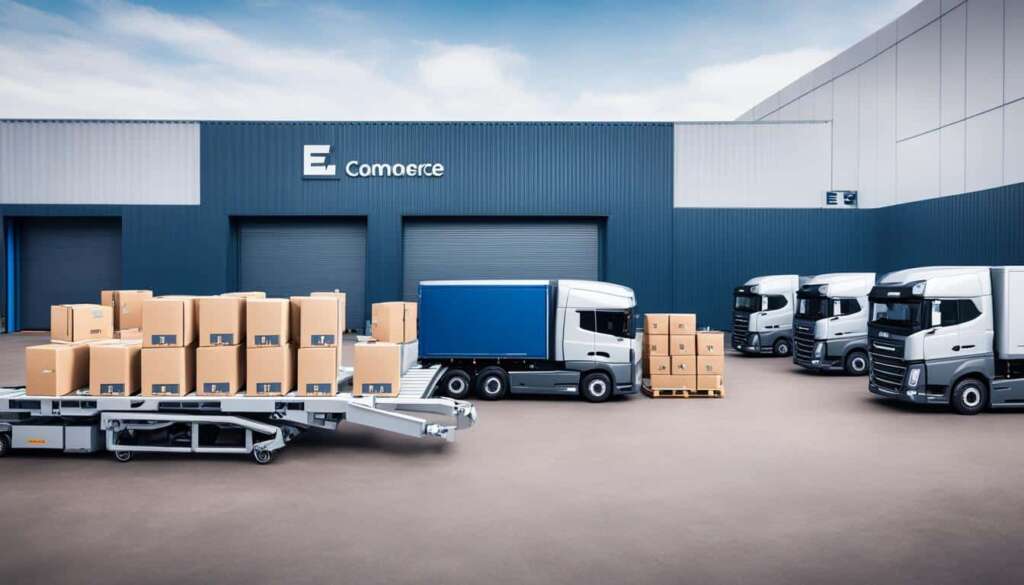Table of Contents
Recent estimates indicate significant growth in the global e-commerce market, with trends showing no signs of slowing down. Building a resilient and optimised e-commerce supply chain is crucial in response to the COVID-19 situation. Supply chain management in e-commerce involves streamlining the flow of information, resources, and money to achieve optimum results. The components of an e-commerce supply chain include producers, suppliers, vendors, logistics, distribution centres, fulfilment companies, and transportation services.
As e-commerce continues to flourish and evolve, businesses must adapt their supply chain management strategies to stay competitive. Optimising the e-commerce supply chain is essential for improving operational efficiency, enhancing customer satisfaction, and driving e-commerce growth.
In this article, we will explore ten ways to optimise your e-commerce supply chain, the benefits of an efficient supply chain, challenges to watch out for, and the importance of sustainability in e-commerce supply chains. By implementing these insights, businesses can stay on top of the dynamic e-commerce landscape and thrive in the online marketplace.
Ten Ways to Optimise E-commerce Supply Chain
Optimising the e-commerce supply chain is crucial for moving products seamlessly through multiple hands and increasing online sales. By implementing effective supply chain management strategies, businesses can enhance efficiency, reduce costs, and meet customer expectations.
- Solidify Communication: Establish clear and efficient communication channels between every link of the supply chain. This ensures smooth coordination and enhances collaboration.
- Centralise Management Operations: Utilise software solutions to centralise and streamline management operations. This allows for better control and visibility throughout the supply chain.
- Adapt to Mobile and Internet Tech: Embrace evolving mobile and internet technologies to improve communication, automate processes, and enhance customer experiences.
- Outsource Redundant Processes: Consider outsourcing non-core processes such as warehousing, inventory management, and order fulfilment to third-party logistics providers. This can help reduce costs and improve operational efficiency.
- Deliver Best-Quality Products: Strive to deliver high-quality products that meet or exceed customer expectations. This builds trust and loyalty among consumers.
- Focus on Customer Expectations and Experience: Prioritise understanding and meeting customer expectations throughout the supply chain. This includes fast delivery, easy returns, and personalised customer service.
- Leverage Analytics Tools: Utilise data analytics tools to gain insights into customer preferences, demand patterns, and supply chain performance. This enables informed decision-making and proactive planning.
- Create a Responsive Supply Chain: Build a flexible and adaptable supply chain that can quickly respond to market changes and fluctuations in demand.
- Plan Meticulously: Thoroughly plan supply chain processes, including inventory management, procurement, and transportation, to avoid disruptions and delays.
- Avoid Supply Chain Complacency: Continuously seek opportunities for improvement and innovation in the supply chain. Regularly evaluate performance metrics and implement strategies for supply chain enhancement.
By implementing these ten ways to optimise the e-commerce supply chain, businesses can enhance operational efficiency, improve customer satisfaction, and achieve sustainable growth in the dynamic e-commerce landscape.
How an Efficient E-commerce Supply Chain Boosts Business
An efficient and transparent e-commerce supply chain offers numerous benefits for businesses operating in the online marketplace. By optimizing the flow of goods and information, businesses can achieve cost savings, reduce delays in order fulfillment, enhance transparency and visibility across the entire supply chain, and improve their multi-channel selling capabilities. Additionally, an efficient e-commerce supply chain strengthens customer relations, enables accurate forecasting, and provides valuable insights into stock availability and inventory visibility.
E-commerce plays a vital role in the supply chain, offering businesses the opportunity to streamline collaboration with suppliers and customers, resulting in efficient and informed decision-making processes. By leveraging software solutions tailored for e-commerce supply chain management, businesses can create a seamless and integrated system that maximizes their operational efficiency and drives growth.
Benefits of an Efficient E-commerce Supply Chain
- Cost Savings: An optimized supply chain allows businesses to reduce operational costs through improved inventory management, supply chain visibility, and accurate forecasting.
- Reduced Delays: By streamlining processes and improving coordination, an efficient e-commerce supply chain minimizes delays in order fulfillment, ensuring timely delivery to customers.
- Transparency and Visibility: Enhanced transparency and visibility throughout the supply chain enable businesses to track and trace products, identify bottlenecks, and make informed decisions.
- Multi-channel Selling: An efficient e-commerce supply chain facilitates seamless integration across multiple channels, enabling businesses to reach a wider customer base and increase sales.
- Improved Customer Relations: By ensuring timely order processing and delivery, businesses can enhance customer satisfaction and loyalty, leading to long-term success.
- Accurate Forecasting: An optimized supply chain allows businesses to accurately forecast demand, avoiding stockouts or overstock situations, and aligning inventory levels with customer demand.
- Stock Availability: With improved visibility into inventory levels, businesses can maintain optimal stock availability, preventing lost sales and dissatisfied customers.
- Inventory Visibility: A transparent e-commerce supply chain provides real-time visibility into inventory, enabling businesses to track product availability and make informed decisions regarding promotions, discounts, and reordering.
By implementing an efficient e-commerce supply chain, businesses can unlock these benefits and gain a competitive edge in the dynamic online marketplace. The integration of technology solutions tailored for e-commerce supply chain management simplifies collaboration, improves operational efficiency, and drives overall business success.

| Benefit | Description |
|---|---|
| Cost Savings | Reduced operational costs through optimized inventory management, supply chain visibility, and accurate forecasting |
| Reduced Delays | Streamlined processes and improved coordination to minimize delays in order fulfillment |
| Transparency and Visibility | Enhanced supply chain visibility for better tracking and informed decision-making |
| Multi-channel Selling | Seamless integration across multiple sales channels to expand reach and increase sales |
| Improved Customer Relations | Timely order processing and delivery for enhanced customer satisfaction and loyalty |
| Accurate Forecasting | Precise demand forecasting to optimize inventory levels and meet customer demands |
| Stock Availability | Maintaining optimal stock levels to avoid stockouts and ensure customer satisfaction |
| Inventory Visibility | Real-time visibility into inventory for informed decision-making and efficient stock management |
E-commerce Supply Chain Challenges to Watch Out For
Although e-commerce presents numerous benefits, it also brings along several challenges that need to be addressed in supply chain management. These challenges include:
- Inventory management: Ensuring accurate inventory levels and efficient replenishment is crucial for e-commerce businesses. With a vast range of products and fluctuating demand, effective inventory management becomes essential to avoid stockouts or overstocking, leading to customer dissatisfaction and potential revenue loss.
- Warehouse sorting: Managing warehouse operations for multiple sales channels can be complex. Each channel may have different order volumes, requirements, and deadlines, which need to be carefully coordinated to ensure timely order processing and delivery.
- Transportation logistics: Efficient transportation logistics are vital for timely and cost-effective product delivery. E-commerce businesses rely on reliable shipping and delivery services to meet customer expectations. However, factors such as capacity limitations, route optimization, and last-mile delivery challenges can impact the overall effectiveness of transportation logistics.
Addressing these challenges requires careful planning, robust systems, and coordination between various stakeholders in the e-commerce supply chain. Overcoming these challenges enables businesses to provide seamless order fulfillment, improve customer satisfaction, and maintain a competitive edge in the dynamic e-commerce landscape.
Overcoming Inventory Management Challenges
“Accurate inventory management is the foundation of successful e-commerce supply chains. By investing in robust inventory management systems and implementing real-time tracking and automated replenishment processes, businesses can ensure optimal inventory levels, reducing stockouts and excess inventory.”
Sustainability in E-commerce Supply Chains
Sustainability is an important aspect of e-commerce supply chains. In today’s world, where environmental issues are at the forefront, retailers have a responsibility to implement sustainable practices throughout the entire supply chain. By prioritizing sustainability, businesses can contribute to a greener future while also gaining a competitive edge in the market.
Using Eco-friendly Packaging Materials
One way retailers can promote sustainability is by using eco-friendly packaging materials. By opting for recyclable, biodegradable, or compostable packaging, businesses can reduce waste and minimize the environmental impact of their operations. Additionally, labels and packaging can be designed using organic, non-toxic, and sustainable materials.
Optimizing Transportation Methods
Another key area where sustainability can be enhanced is transportation. Retailers can optimize their transportation methods to reduce emissions and minimize the carbon footprint associated with delivering products. This can include using alternative fuels, efficient route planning, consolidating shipments, and leveraging technology to improve logistics.
Promoting Supply Chain Transparency and Responsible Sourcing
Supply chain transparency is vital for sustainability. By ensuring visibility and traceability throughout the supply chain, retailers can identify and address any unethical or unsustainable practices. Responsible sourcing of raw materials and products from suppliers who adhere to sustainable standards and practices is also crucial for a sustainable supply chain.
Adopting Circular Economy Practices
One of the key concepts in sustainability is the circular economy. Retailers can contribute to the circular economy by implementing practices such as product life extension, recycling, upcycling, and waste reduction. This approach aims to minimize waste by keeping materials and products in use for as long as possible.
Ensuring Social Responsibility
Social responsibility plays a significant role in sustainability. Retailers should prioritize the well-being of workers throughout the supply chain, ensuring fair wages, safe working conditions, and ethical labor practices. By partnering with suppliers who adhere to these principles, businesses can demonstrate their commitment to social responsibility.
| Sustainability in E-commerce Supply Chains | Benefits |
|---|---|
| Eco-friendly packaging materials | – Reduces waste and environmental impact |
| Optimized transportation methods | – Minimizes emissions and carbon footprint |
| Supply chain transparency and responsible sourcing | – Supports ethical and sustainable practices |
| Circular economy practices | – Minimizes waste and maximizes resource efficiency |
| Social responsibility | – Ensures fair labor practices and worker well-being |
Implementing these sustainability practices not only benefits the environment but also enhances brand reputation and customer loyalty. Consumers today are increasingly conscious of the environmental and social impact of their purchasing decisions, and they are more likely to choose retailers that align with their values.

“Sustainability is not about compromise, it’s about innovation and finding better ways to do business that protect our planet and ensure a brighter future for generations to come.” – Patagonia
Conclusion
In today’s rapidly growing e-commerce industry, optimizing the supply chain is essential for businesses to thrive. By implementing a few key strategies, companies can enhance efficiency, improve customer satisfaction, and achieve overall success.
Effective communication is at the heart of a well-optimized e-commerce supply chain. Establishing strong lines of communication between all stakeholders ensures smooth coordination and minimizes delays.
Centralized management with the help of software solutions streamlines operations, allowing businesses to easily monitor and control every aspect of the supply chain. Adapting to evolving technology is also crucial, as it enables integration of mobile and internet tech that can enhance productivity and customer experience.
In addition, outsourcing non-core processes allows businesses to focus on their core competencies while leveraging external expertise. By delivering high-quality products that meet and exceed customer expectations, businesses can build trust and loyalty among their target audience.
Leveraging analytics tools provides valuable insights for proactive decision-making and improves supply chain responsiveness. Meticulous planning and continuous improvement help identify and resolve any bottlenecks in the supply chain.
By optimizing the e-commerce supply chain through these key takeaways, businesses can unlock significant benefits, including increased efficiency, enhanced customer satisfaction, and improved bottom-line results in this increasingly competitive industry.
FAQ
What is supply chain management in e-commerce?
Supply chain management in e-commerce involves streamlining the flow of information, resources, and money to achieve optimum results. It includes managing the various components of the e-commerce supply chain, such as producers, suppliers, vendors, logistics, distribution centres, fulfilment companies, and transportation services.
How can I optimise supply chain management in e-commerce?
Some proven ways to optimise supply chain management in e-commerce include solidifying communication between every link of the supply chain, centralising management operations with software solutions, adapting to integrate evolving mobile and internet tech, outsourcing redundant processes, delivering best-quality products, focusing on customer expectations and experience, leveraging analytics tools, creating a responsive supply chain, planning meticulously, and avoiding supply chain complacency.
What are the benefits of an efficient e-commerce supply chain?
An efficient and transparent e-commerce supply chain can lead to significant benefits for businesses. These benefits include cost savings, reduced delays in order fulfillment, greater transparency and visibility across the supply chain, effective multi-channel selling, improved customer relations, accurate forecasting, insight into stock availability, and inventory visibility. E-commerce and software solutions simplify collaboration with suppliers and customers, streamlining decision-making processes.
What challenges does e-commerce present for supply chain management?
Some challenges of e-commerce supply chain management include inventory management, ensuring accurate inventory levels and efficient replenishment, managing warehouse sorting for multiple channels, and handling transportation logistics to ensure timely and cost-effective product delivery.
How can sustainability be incorporated into e-commerce supply chains?
Retailers can incorporate sustainability into e-commerce supply chains by using eco-friendly packaging materials, optimizing transportation methods for reduced emissions, promoting supply chain transparency and responsible sourcing, adopting circular economy practices, and ensuring social responsibility throughout the supply chain.
What are the key takeaways for optimising the e-commerce supply chain?
The key takeaways for optimising the e-commerce supply chain include the importance of communication, centralised management, adapting to evolving tech, outsourcing non-core processes, delivering quality products, focusing on customer expectations, leveraging analytics, creating a responsive supply chain, planning meticulously, and continuously improving the supply chain. Implementing these strategies will help businesses enhance efficiency, customer satisfaction, and overall success in the e-commerce industry.







